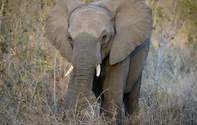
In what is probably the largest fertilisation experiment of its kind, 30 hectares of mopane bushveld in the Timbavati Private Nature Reserve adjoining the Kruger National Park (KNP) have been fertilised with nitrogen, phosphorous and potassium fertiliser. The aim is to see how enhancing the vegetation growing there changes the local distribution of elephants and other herbivores and influences their behaviour.
The fertilisation experiment is part of a large five-year research project that will keep six doctoral students and a dozen masters students busy spying on elephants, other herbivores, trees and grasses for the next four years in the Timbavati, Klaserie and Umbabat Private Nature Reserves.
It will also keep a variety of eminent scientists from Europe, Australia, America and South Africa occupied in an attempt to create a model that will predict how elephants and other herbivores distribute themselves on a scale ranging from tens of kilometres to thousands of kilometres, and over varying time periods, ranging from a single season to several years.
The experiment, known as Tembo - The Elephant Movements and Bio-Economic Optimality Programme - will help wildlife managers to fine tune and optimise their management of elephant populations.
Any reserve or national park with elephants in it has to weigh up conflicting needs - the money that elephants can earn through ecotourism or hunting, and the damage the animals can do to biodiversity.
The Tembo programme will help produce the optimal elephant management strategy for wildlife managers, taking both financial and environmental factors into consideration. Fieldwork during the project will range from studying satellite images to studying what plant an elephant is busy stuffing into its mouth.
Elephants will be collared with GPS collars, and data collected during previous elephant census operations will also be used. Two researchers have already started their fieldwork. Cornelis van de Waal, who initially broadcast the fertiliser over plots of mopane veld of varying sizes, is looking at how the plants take up the added nutrients.
He is particularly interested in how the scale of fertilisation affects plant ecology - what happens if nutrients are added to an area small enough to only benefit grass roots versus an area covering the entire root system of a tree. Leaf samples will be taken during the year and chemically analysed to find out how the added fertiliser is being taken up and used by the trees and grasses.
Cornelis will also be selecting 56 individual mopane trees to monitor the different effects nitrogen and phosphorous have on tree growth. Another fertilisation experiment investigates how adding nutrients affects the competition for nutrients between mopane trees and grasses.
Yolanda Pretorius has also started her fieldwork, and late October saw the first Tembo elephant collared. Five other elephants will be collared so that the paths they take when looking for food can be identified.
Of particular interest will be which plant species are preferred and which are avoided, so that Yolanda can then sample leaves from the plants to check if the elephants are selecting certain species because of their specific nutrient content.
Yolanda will confirm visual observations of what the elephants are eating by collecting fresh dung samples and identifying their contents under the microscope. Each species of plant has a particular structure in the cells just below the leaf 's surface, and this can be used like a fingerprint to identify different species.
Analysing these data will produce models that are able to predict whether elephants would be absent or present under varying field conditions over the year. She has also been monitoring other herbivores, especially impalas, for their foraging behaviour and changes in distribution.
Cleared strips of land around the fertilisation experiments show the spoor of the animals which have been entering the fertilised areas, and which fertiliser concentration has attracted the most animals. Yolanda says that preliminary observations show that buffalo are favouring the smallest, most heavily fertilised plots as feeding spots.
A third PhD student is working on remote sensing, linking satellite data about quality and quantity of forage to large herbivore distribution. Further PhD students will be slotting into the research programme this year studying the effects of elephants on mopane; upscaling point-based observations to the landscape scale; studying the indirect effects of elephants on other herbivore species; and economic benefit sharing models.
By Melissa Wray

 African Wildlife Research - The enquiring mind of humanity is our most important asset in the struggle for physical survival on earth. The ...
African Wildlife Research - The enquiring mind of humanity is our most important asset in the struggle for physical survival on earth. The ...